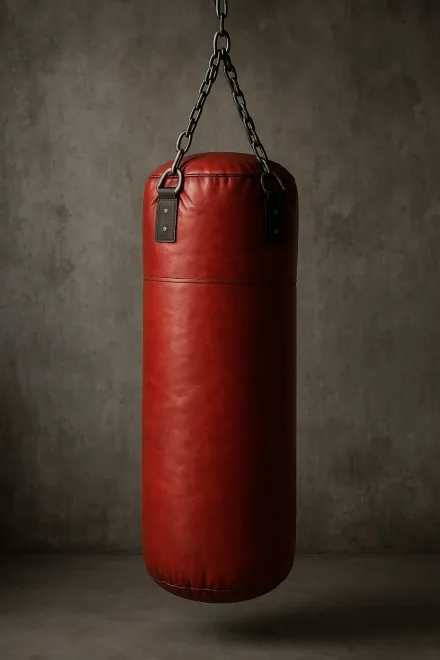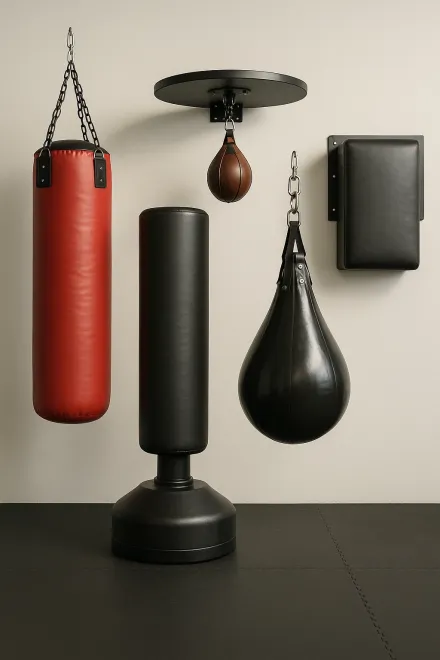Punching bags
Punching bags are one of the most versatile and effective tools for anyone looking to improve their technique, fitness, and strength. Whether you're a beginner training at home or an advanced boxer perfecting your punches, the punching bag adapts to different levels of experience and goals. Besides helping you release stress, training with a bag works coordination, endurance, and power, making it an essential ally both in gyms and personal home workouts.
See recommended punching bags on Amazon
What is a punching bag and what is it for?
A punching bag is a training tool designed for practicing punches, kicks, and martial arts combinations. It usually consists of a durable cover, filling, and a support system that allows it to hang or stand on the floor. Its use is not limited to professional boxers: it's also ideal for those wanting to improve fitness, burn calories, or release tension after work.
Training with a bag works muscles such as shoulders, arms, back, abs, and legs. It also boosts cardiovascular capacity, since an intense punching session becomes an effective aerobic workout. Another important aspect is the psychological side: hitting the bag with technique and rhythm helps channel stress and build confidence in movements.
In short, a punching bag serves both professional training and recreational use, and it's a key accessory in boxing, muay thai, kickboxing, or MMA.
Types of punching bags
There are different types of punching bags, and choosing the right one depends on your level, discipline, and available space. The most common are:
- Classic hanging bag: the most used in gyms and home workouts. It hangs from the ceiling or a frame and offers a realistic striking experience.
- Freestanding or pedestal bag: ideal for those who can't hang a bag at home. It stays stable thanks to a base filled with sand or water.
- Speed bag: designed to train speed, reflexes, and coordination. It's usually installed on fixed platforms.
- Water bag: filled with liquid, it better simulates body impact and reduces hand injury risk.
- Wall-mounted bag: made for strength training and combinations in small spaces.
Each type has its pros. Hanging bags allow more mobility, while pedestal ones are more practical if space is limited. The key is choosing the one that fits your training needs and space.


How to choose the right punching bag
When buying a punching bag, there are several factors to consider for the right choice. Here are some key aspects:
- Bag weight: a light bag moves a lot and suits beginners, while a heavier one offers resistance for power training.
- Cover material: synthetic leather is affordable and resistant, natural leather lasts longer, and vinyl is ideal for recreational use.
- Filling: may be compressed textiles, sand, water, or foam. The filling affects hardness and striking feel.
- Available space: measure where you'll install it, especially if it's hanging. If space is tight, consider a freestanding bag.
- Sport discipline: boxing focuses on hand strikes, while in kickboxing or MMA a longer bag is better for training kicks.
In conclusion, the right bag will be the one that fits your level, training style, and available space.
Benefits of training with a punching bag
Training with a punching bag offers multiple benefits, both physical and mental. Beyond improving striking technique, it's a full workout that can be part of fitness routines or self-defense programs.
Some of the main benefits are:
- Improved fitness: a 30-minute session can burn 300–500 calories, ideal for weight loss or staying fit.
- Strength and endurance development: repetitive strikes on a medium or heavy bag strengthen upper and lower body muscles.
- Cardio training: working in high-intensity intervals boosts the heart and improves lung capacity.
- Better coordination: combining strikes with movement demands coordination and body control.
- Stress relief: hitting the bag releases endorphins, clears the mind, and reduces anxiety.
It's also adaptable to any level: from beginners to pro athletes, anyone can benefit by adjusting intensity and session length.
Tips for proper training with a punching bag
Training with a punching bag is effective, but to get results and avoid injuries it's essential to use proper technique. Here are some practical tips:
- Use wraps and gloves: always protect your hands and wrists to prevent knuckle and joint injuries.
- Warm up before striking: do dynamic stretches and mobility work to prepare your body.
- Work with combinations: don't just throw single punches, mix jabs, hooks, and uppercuts with footwork.
- Control intensity: alternate strong rounds with lighter ones, simulating a real fight rhythm.
- Stance and guard: keep your guard high, feet moving, and weight balanced.
- Add kicks if you practice martial arts: in muay thai or kickboxing, the bag is perfect for low and high kicks.
- Finish with stretching: after training, spend a few minutes stretching worked muscles for better recovery.
If you're a beginner, it's best to start with short rounds of 2–3 minutes, with rests in between. Over time you can increase duration and intensity as you progress.
FAQs about punching bags
What weight should a punching bag have for beginners?
For beginners, a bag between 25 and 35 kg is usually ideal. It's light enough to allow mobility and avoid joint strain, but still offers resistance for technique training. If it's too heavy, learning becomes harder; if too light, it moves excessively. The best is choosing a weight that matches your strength and experience.
Is a hanging or freestanding bag better?
It depends on space and training style. Hanging bags give a more realistic experience and allow footwork, making them the top choice in gyms. But if you can't drill walls or ceilings, a freestanding bag with a sand or water base is a practical and versatile alternative. For home training without complex setups, it's often the best option.
What is the best filling for a punching bag?
Filling depends on the striking feel you want. Compressed textile bags are the most common and balanced. Sand makes the bag harder but raises injury risk. Water bags better simulate body impact and reduce hand damage. Foam bags are great for beginners since they provide a softer hit.
How much space do I need to set up a punching bag?
To train comfortably, it's best to have at least 2x2 meters of free space. This way you can move around the bag and practice dodging. If it's a hanging bag, consider ceiling height and ensure it hangs at shoulder level. For freestanding ones, check that the base fits your available space.
Can a punching bag be used for weight loss?
Yes, training with a punching bag is one of the most effective ways to burn calories. A 30–45 minute session can burn 400–600 calories, depending on intensity. It also combines cardio with muscle strengthening, making it a complete workout for dynamic and fun weight loss.
Do I need gloves to train with a punching bag?
Yes, it's always recommended to use gloves and wraps when training with a punching bag. This protects hands, knuckles, and wrists from injury. Striking without protection can cause abrasions, swelling, or even fractures. For light training, you can use thinner gloves, while traditional boxing gloves are best for intense sessions.
How often should I replace my punching bag?
A bag's lifespan depends on its material, filling, and usage intensity. A quality bag can last 3–5 years with regular training. However, if it loses shape, filling sinks in spots, or the cover starts tearing, it's time to replace it. Natural leather bags usually last longer than vinyl or synthetic leather ones.
